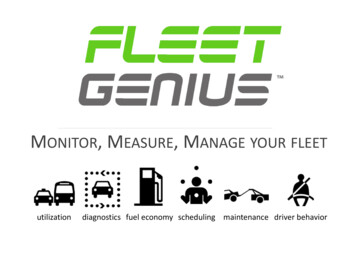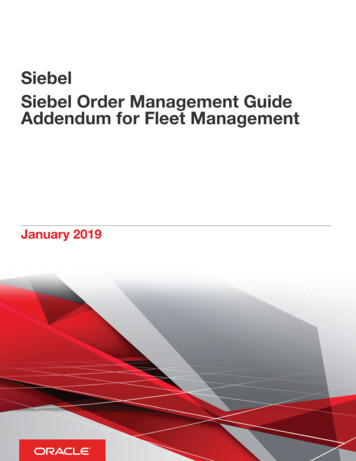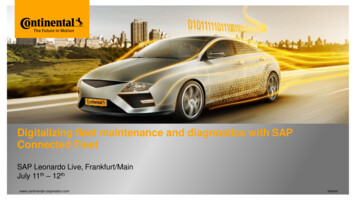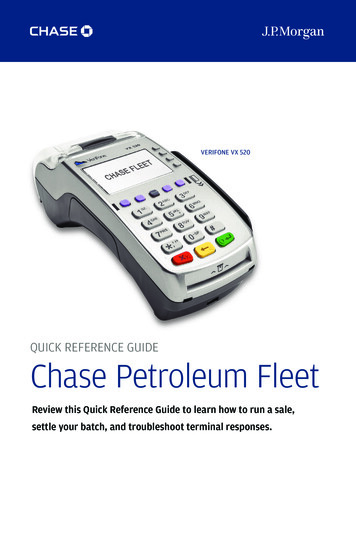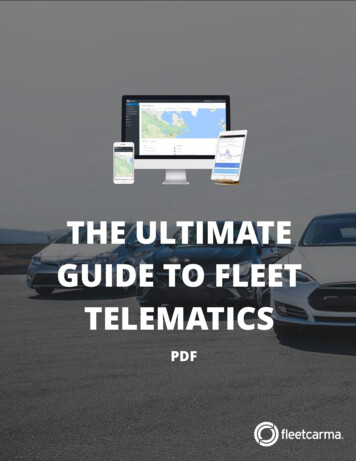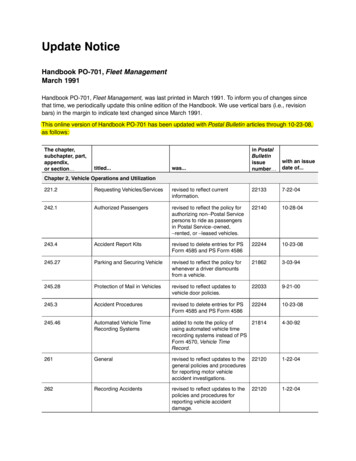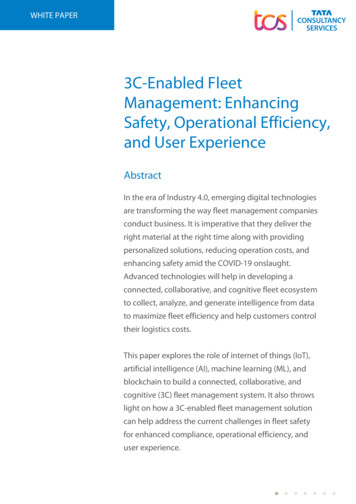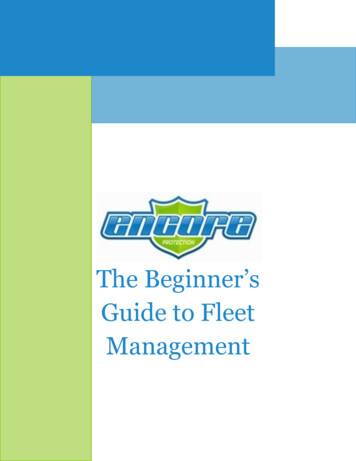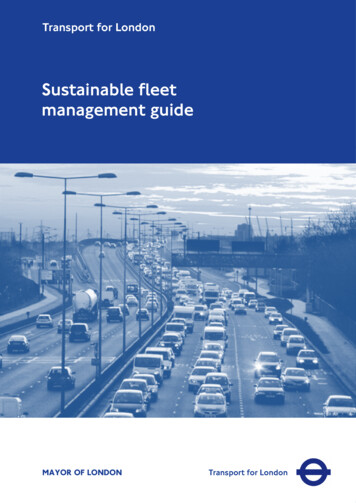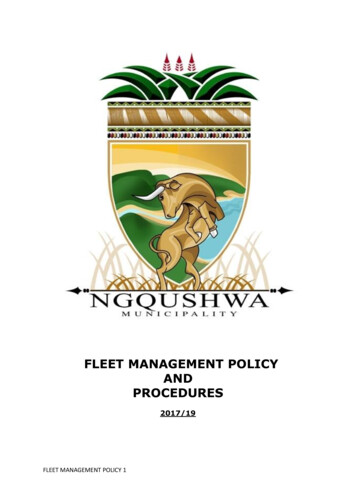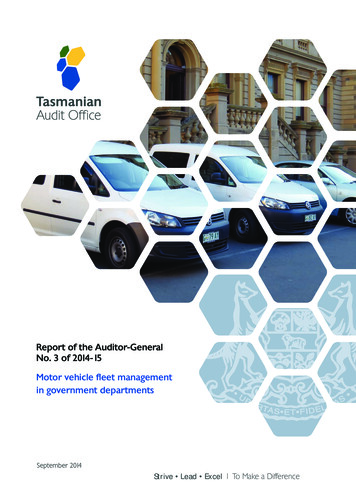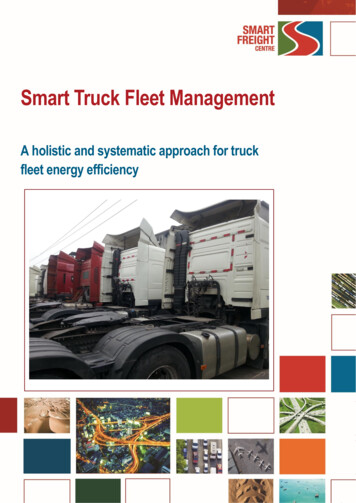
Transcription
Smart Truck Fleet ManagementA holistic and systematic approach for truckfleet energy efficiency
Smart Freight Centre 2017. Smart Truck Fleet ManagementThis publication may be reproduced in whole or in part in any form for educational or non-profit purposeswithout special permission from the copyright holder, provided acknowledgment of the source is made. SmartFreight Centre would appreciate receiving a copy of any publication that uses Smart Truck Fleet Managementas a source. No use of this publication may be made for resale or for any other commercial purposewhatsoever, without prior permission in writing from Smart Freight Centre.DisclaimerThe views expressed in this publication are those of Smart Freight Centre and staff, consultants andmanagement, and do not necessarily reflect the views of the Board of Trustees of Smart Freight Centre. SmartFreight Centre does not guarantee the accuracy of the data included in this publication and does not acceptresponsibility for consequence of their use.AcknowledgementsThis report was written by Sophie Punte, Boyong Wang, Su Li, Bonne Goedhart and Chris Douglas of SmartFreight Centre.About Smart Freight CentreSmart Freight Centre is a global mission-driven organization dedicated to a more efficient and low-emissionsglobal freight sector. We bring together the global logistics community to drive transparency and mobilizemultinational companies and their logistics partners to take action. This is done through global industryguidelines and solutions for emissions calculation, reporting and reduction, the first of which is the GLECFramework, and by recognizing Smart Freight Leaders. To scale our impact we are present in Europe, theAmericas and Asia and collaborate with existing initiatives, partner organizations and experts worldwide.ContactSmart Freight CentreKeizersgracht 560, 1017 EM, Amsterdam, NetherlandsP.O. Box 11772, 1001 GT, Amsterdam, NetherlandsTel office: 31 6 4695 tre.orgTable of ContentsExecutive Summary . 21. Introduction . 32. Barriers for road freight operators . 53. Smart Truck Fleet Management . 74. Implementing Smart Truck Fleet Management . 84.1 Training course: Smart Transport Manager Training . 84.2 Knowledge products to support action plan implementation . 94.3 Building a community . 9References . 10
Smart Truck Fleet ManagementExecutive SummarySignificant efforts are necessary to curb emissions from global freight. While no mode should escape effortsto curb carbon emissions, road freight represents two-thirds of global freight emissions, and therefore trucksis where big gains are to be realized.A key piece of the puzzle is mobilizing road transport operators. Improving energy efficiency and reducingemissions from truck fleets will take more than the availability of technologies and measures and legislationand standards.A holistic and locally adaptable approach to energy management of truck fleets – Smart Truck FleetManagement - consists of five pillars: fuel management; driver and staff skills development; vehicles andmaintenance; performance monitoring; and utilizing information technology. This is put into practice throughSmart Transport Manager training to develop an action plan, knowledge products, and a community of SmartTransport Managers together with shippers as their customers, suppliers and other stakeholders they interactwith.Upskilled transport managers make better decisions on technology and best practice interventions. Freightoperators that employ them benefit from more efficient fleets and reduced operating cost and emissions. Theyare likely to be preferred by leading shippers and logistics service providers that care about mitigating theclimate impacts from freight.Given the global nature of logistics supply chains, a harmonized approach to truck fleet efficiency can help toconvince multinational shippers to support trucking initiatives around the world. It is recommended that theSmart Truck Fleet Management framework is adopted globally by multinationals and programs and initiatives.The approach can be adapted to the local situation to maximize local impact and global exchange.Smart Freight Centre’s aim is to work together with leading businesses, initiatives and key stakeholderstowards professionalized road freight operators for fleet energy management. Efforts to decarbonize the globalfreight sector cannot succeed without them.2
Smart Truck Fleet Management1. IntroductionFreight transport serves the global economy by transporting goods from producers to a growing consumermarket. It is demand-driven and heavily influenced by multinational corporations (MNCs) that mostly outsourceto logistics partners. According to the International Transport Forum (OECD/ITF, 2017) the sector generates7-8% of global and 42% of transport greenhouse gas (GHG) emissions and is a major contributor to airpollution. A 19-64% reduction by 2015 is required compared to 2015 in line with the 1.5-2oC scenario agreedunder the Paris Climate Agreement, and over 80% if freight growth is considered.Figure 1 – Freight contribution to global GHG emissionsFigure 2 – Freight GHG reductions by 2050While road holds 18% of freight tonne-km globally, two-thirds of freight GHG emissions are attributable totrucks (OECD/ITF, 2017). The truck market is changing focus towards emerging economies; by 2050, the USand EU will account for only 10% of the global truck sales, down from 20% today. Furthermore, 7% ofinternational trade occurs within national borders, yet about 30% of total trade-related CO2 is emitted here(OECD/ITF, 2017; IEA, 2013). Without further policy efforts, trucks will account for 40% of the oil demandgrowth to 2050 and 15% of the increase in global GHG emissions from oil (IEA, 2017). Road freight operatorsare predominantly large in number and small in fleet size. That fragmentation results in inefficiencies – andopportunities for savings through performance improvements. While no mode should escape efforts to curbcarbon emissions, trucks is where the biggest gains are to be realized.Under a modern truck scenario of the International Energy Agency, trucking fuel use could reduce by 50% andemissions by 75% in 2050 compared to 2015. By 2030, approximately 28% emission reductions could beachieved, but this still excludes modal shift from trucks to less carbon-intensive modes (IEA, 2017).3
Smart Truck Fleet ManagementSolutions to reduce emissions across modes exist and include: reduce demand for freight transport, optimizefreight transport modes, increase transport asset utilization, improve fleet energy efficiency, and reduce carboncontent of energy (McKinnon, 2018).Figure 3 shows a Smart Freight Solutions Map for road freight, whereby solutions are mapped based on theirpotential energy or CO2 reductions and the feasibility of their adoption at scale (Smart Freight Centre, 2017,based on Greening, 2016 and Cebon, 2016).Figure 3 – Smart Freight Solutions Map for Road FreightRoad freight operators have the greatest influence on their fleet utilization, efficiency and choice of fuel. It isessential to mobilize transport operators to improve energy management of their truck fleets. They can benefitfrom fleet efficiency in numerous ways, all of which contribute to profitability: better vehicle, driver and fuelresource utilization, reduced empty running, maximizing loading by weight, volume and deck length, minimizingduplicate or lost mileage. This paper explores the barriers road freight operators face, the Smart Truck FleetManagement (STFM) framework, what is needed to implement it, lessons learned from existing initiatives, andconclusions and recommendations.4
Smart Truck Fleet Management2. Barriers for road freight operatorsMultinational shippers and logistics service providers that want to reduce their carbon footprint are to a largedegree dependent on what their subcontracted transport operators do. While this is the case for all modes,this especially applies to road freight due to the many layers of subcontracting and carrier fragmentation. Forexample, small contractors using old vans for urban deliveries. To this end, SFC developed a map and analysisof barriers that road freight operators face to adopt fuel saving and emission reducing technologies andmeasures as shown in Figure 4 (Smart Freight Centre, 2017b, based on own research and ICCT, NACFE andCSS, 2013; ICCT and CE Delft, 2012; Huang et al, 2008; Zhang et al, 2014).Barriers exist, both internal and external. Internal barriers relate to obstacles within the organization boundariesand that are mostly within management’s control. There are four categories of internal barriers: reactivemanagement, management systems, finance, and awareness & capacity. External barriers relate to outsidefactors and players over which road freight operators have little or no direct influence. The four categories ofexternal barriers are: market forces, institutions & policies, partners & programs, and technologies & measures.Figure 4 – Barriers for Road Freight OperatorsAll these barriers are interconnected and often re-enforce each other. To get a holistic understanding ofexisting barriers we must realize that the global freight sector is first and foremost a commercial and demandresponsive sector. Market forces, an oversupply of road freight operators and high fragmentation have createda cut-throat competitive sector that puts road freight operators under an enormous pressure to survive. This inturn contributes to reactive management within road freight operators, their ability to finance technologies andmeasures and invest in management systems and internal capacity building. The other external barriers furtherweaken road freight operators’ ability to become more fuel efficient.It is important to focus on what barriers can be realistically addressed, in a concerted effort that looks at allidentified barriers holistically, while involving road freight operators, their immediate partners such as OEMsand technology suppliers and broader stakeholders such as trade associations and government authorities.First, while it is tempting to focus on market forces, this is not realistic. A better approach is to focus on barriersthat road freight operators have more control over, such as management systems or awareness and capacity,or that partner NGOs and government agencies can address, such as policies and programs. Second,5
Smart Truck Fleet Managementaddressing one barrier in isolation is not going to solve the problem. For example, a combination is needed ofclear policies and technology standards which can a) build trust in technologies available on the market; b)increase fleet managers’ ability to assess which technologies and suppliers are the best fit; c) improvemanagement systems that generate data for a strong business case to management; and d) provide a solutionto overcome cash flow challenges to invest. A similar approach will help the uptake of operational opportunitiesfor fleet energy efficiency.Many initiatives exist to help road freight operators, most importantly: Existing industry-backed efforts in support of technology research, testing and adoption (e.g. Centre forSustainable Road Freight, and the University of Montevideo); an initiative backed by cargo owners/shippersEuropean Technology Platform ALICE; and work by ACEA/IRU on the Commercial Vehicle of the Future. Existing platforms that promote adoption of road freight technologies and measures (e.g. Truck van deToekomst, or “Truck of the Future” in the Netherlands (now completed), Trucking Efficiency in NorthAmerica, Low Carbon Vehicle Partnership in the UK, and Green Trucks Partnership in Australia. Green Freight Programs that companies can join to work together on emissions measurement andreduction. Worldwide there are about 13 operational green freight programs (Smart Freight Centre, 2017c).The Global Green Freight Action Plan of the Climate and Clean Air Coalition (CCAC, 2015) aims toharmonize and spread these programs worldwide, and SFC is a leading partner in this. Some of theprograms with supporting information on truck and fleet technologies and measures, and the benefits thatthey bring, are EcoStars in the UK and Europe (providing written and video case studies), ObjectifCO2 inFrance and SmartWay in the US and Canada.6
Smart Truck Fleet Management3. Smart Truck Fleet ManagementA holistic and integrated approach to energy management of truck fleets – Smart Truck Fleet Management(STFM) - consists of five pillars: fuel management; driver and staff skills development; vehicle, system andcomponent specification and preventive maintenance; performance monitoring; and utilizing informationtechnology. This framework was developed drawing from various programs and initiatives.Having such a framework can help with the harmonization of different schemes for road freight operators, aswell as facilitate exchange between existing local initiatives. What makes this framework unique is that it looksat the management of fleet, and not merely at the deployment of technologies. What is apparent is that thatroad freight operators are not equipped or experienced in managing their fleet to fully address the challenge:selecting the right vehicles, looking at the ‘right’ KPIs, or training drivers and staff, to name a few.Figure 5 - Five pillars of Smart Truck Fleet Management7
Smart Truck Fleet Management4. Implementing Smart Truck Fleet ManagementSmart Truck Fleet Management can be introduced in a country or market in three ways: training course,knowledge products, and building a community of Smart Transport Managers together with their customersand partners. Evidence exists from various initiatives around the world that this works. Change at scale canbe realized if it is introduced more systematically in different markets.4.1 Training course: Smart Transport Manager TrainingTransport managers play key roles in the operations of road freight operators as they look after the operation’sresources – and are responsible for safety, compliance and customer service, as well as maximizing resourceutilization and reducing operating costs. They maintain relations with customers, senior management, financestaff, maintenance staff and fitters, and drivers, amongst others. They face ongoing internal and externalpressures. These include meeting customer expectations, ensuring legal compliance, minimizing their fleets’environmental impact and reducing operating costs. The key question is how do transport managers identify,evaluate and select measures and interventions to improve efficiency for their specific fleet?A scan of existing training available to transport managers concluded that programs focus mainly on healthand safety compliance issues, that programs that also deal with fuel efficiency improvement are notcomprehensive, and more training exists for eco-driving which is only one element of fleet management.The Smart Transport Manager Training was developed by Smart Freight Centre in 2017 to upskill operationaltransport managers. The course equips them to become elite professionals on the five pillars of efficient truckfleet management. Each participant has developed an action plan specific to the truck fleet he/she manages.An SFC specialist reviews and approves the Action Plan and prepares a supporting ‘road map’ to give feedbackon encourage implementation of the Action Plan by the transport manager. SFC then issues a Smart TransportManager certificate and the transport manager is admitted to the community of Smart Transport Managers.To enable global applicability/comparability the course was developed at the European QualificationsFramework (EQF) level 4. Core training materials include a training remit, trainer guide; slide pack, casestudies and an Action Plan template.The core course can be adapted to different markets by including local examples, suppliers and relevantpolicies. This was done for China where the localized training has been delivered to 44 transport managersacross 25 road freight road freight operators. Introducing the training in a specific market requires localpartnering, content relevance review, localizing, piloting, revising and roll-out.The training course may be sponsored or supported by stakeholders of transport operators, such asmultinationals as customers of freight transportation, an industry association, or development agency. Theyreceive an anonymized summary report for participating carriers on actions most frequently selected and thetype of support needed, so that they can continue to help carriers with implementation efforts.Smart Transport Managers continuously strive for and deliver on fuel efficiency improvements. They can dothis because they have: The skills to assess the various aspects of fleet operations which determine fuel use Access to state of the art, best practice case studies The knowledge to develop, implement, review and promote effective fuel management action plans for theirown fleets. Basic fuel management programs (like those resulting from their Action Plans), are proven tosave at least 5% in the first year of implementation (UK DfT, 2009).Benefits from the Smart Transport Manager Training and implementation of the resulting Action plan apply to: Transport managers that as certified Smart Transport Managers they will stand out from their uncertifiedpeers as being more skilled, credible and professional. Over time they will be seen as attractive recruits by8
Smart Truck Fleet Managementthe very best green road freight operators. The profession of transport managers is enhanced globallythrough an increased profile, respect and professionalism. Freight operators as employers of these transport managers as their fleets will become more efficient andoperating costs are reduced. They are also likely to be preferred by leading shippers and logistics serviceproviders that care about mitigating the climate impacts from freight. Multinational and national shippers and LSPs who make use of outsourced road freight services and wantto find a way to mobilize reduction efforts by subcontracted carriers, ideally in collaboration with othershippers to maximize impact. Society, which benefits from reduced emissions and fuel consumption.4.2 Knowledge products to support action plan implementationTrained transport managers need additional knowledge products to turn their plan into practice Support toimplement action plans can take the form of, for example, guidance, fact sheets, emissions calculation tool,suppliers’ lists or a combination of these. These can be tailored to different markets.Developing these can build on the vast materials already available through existing schemes and localpartners. The toolboxes of the following initiatives stand out for their practical nature and help companies makemore informed purchases: North American Council for Freight Efficiency (NACFE) released 15 Confidence Reports that independentlyevaluate more than 60 fuel efficiency technologies. Technologies are rated from low to high based on theamount of information available and the payback period. The ObjectifCO2 program in France developed a freight best practices catalogue with ‘Action Sheets’ for54 solutions tailored to four different truck types, and these were translated from French into English andSpanish. The SmartWay program now spans the US, Canada and Mexico. Its Technology Program tests and verifiesemissions reductions and fuel savings for various available technologies, such as aerodynamics, idlereduction technologies and low rolling resistance tires. SmartWay also provides suppliers’ lists for verifiedtechnologies, case studies, fact sheets, technical bulletins and educational materials on fuel-efficienttechnologies, fleet movement and modal shift. The municipality-led EcoStars program in the UK developed a fleet efficiency Road Map to help road freightoperators progress through the scheme’s 5-star rating system, and that covers actions in six categories. The SRF Optimiser, which is a web-based decision support tool that calculates GHG emissions, energyconsumption and costs associated with a company’s road freight transport operation. It models the effectsof 29 carbon-reducing measures, the tool assesses the GHG, energy and cost implications of a range oftechnologies and management practices that can be applied to a transport fleet (Centre for SustainableRoad Freight).4.3 Building a communityThe power comes from building a growing community of certified Smart Transport Managers in differentmarkets that can be internationally connected. Through the continued creation of knowledge products andavailability through these communities, learning and exchange keeps continuing.Interaction between transport managers will significantly enhance exchange of challenges and solutions.Events can be held online or in person, and most likely at a national level involving local partners. Onepossibility is workshops between (trained) road freight operators and their customers, whether multinationalsor national shippers that go deeper into specific solutions that operators can implement. Depending on thesolution covered in these workshops, relevant suppliers, OEMs, associations, research institutes andgovernment agencies can be invited. These can grow into annual events coined ‘Smart Trucks Day”. Anotheroption is to hold an event linked to, for example, IRU global events, events of green freight programs, ortrucking shows.9
Smart Truck Fleet ManagementReferences Cebon, D. (2016). Based on a slide by Dr David Cebon, Centre for Sustainable Road Freight, in his presentation at the IEA-JRC joint workshop, “The future role of trucks for energy and environment,” November 8, 2016 (summary andpresentations available online at: r-energy-and-environment.html).Centre for Sustainable Road Freight, “SRF Optimiser,” http://www.csrf.ac.uk/Climate and Clean Air Coalition (CCAC, 2015), Global Green Freight Action Plan - reducing the climate and healthimpacts of goods default/files/downloads/GreenFreightActionPlan May2015-3 1.pdfDepartment for Transport, UK (DfT, 2009), The Fuel Efficient Trucks Driver’s ook.pdfEcoStars, http://www.ecostars-uk.com/European Technology Platform ALICE, http://www.etp-logistics.eu/FleetSmart, 6FORS, www.fors-online.org.ukGreen Trucks Partnership, een-truck-partnership/index.htmlGreening, P. (2016). Based on a slide by Dr Phil Greening, Centre for Sustainable Road Freight, in his presentationat the IEA-JRC joint workshop, “The future role of trucks for energy and environment,” November 8, 2016 (summaryand presentations available online at: r-energy-andenvironment.html).International Council on Clean Transportation (ICCT), CE Delft (2012), “Market Barriers to Increased Efficiency in theEuropean On-road Freight es/publications/CE Delft 4780 Market Barriers Increased Efficiency European Onroad Freight Sector def-2.pdfInternational Council on Clean Transportation (ICCT), North American Council for Fuel Efficiency (NACFE), CascadeSierra Solutions (CSS), 2013, Barriers to the Increased Adoption of Fuel Efficiency Technologies in the NorthAmerican On-Road Freight Sector. tions/ICCT-NACFECSS Barriers Report Final 20130722.pdfInternational Energy Agency (IEA, 2013), IEA global outlook ions/publication/WEO2013.pdfInternational Energy Agency (IEA, 2017), The Future of Trucks – implications for energy and the onsforEnergyandtheEnvironment.pdfInternational Road Transportation Union IRU, 2017), Commercial Vehicle of the Future - A roadmap towards fullysustainable truck operations. Written by Transport & Mobility Leuven, dfLow Carbon Vehicle Partnership, http://www.lowcvp.org.uk/McKinnon, A. (2018), Decarbonizing Freight. th American Council for Freight Efficiency (NACFE). Confidence Reports. /ObjectifCO2, http://www.objectifco2.fr/OECD/ITF (2017), ITF Transport Outlook 2017. -outlook-20179789282108000-en.htmSAFED. http://www.dft.gov.uk/rmd/project.asp?intProjectID 9986Smart Freight Centre (2017), Smart Freight Solutions Map. lutionsmapSmart Freight Centre (2017b). Barriers for Carriers – Insights on barriers to adopting fuel saving technologies andmeasures for trucks. mart Freight Centre (2017c), Green Freight Programs nfo/publicationsSmartWay, https://www.epa.gov/smartwayTruck van de Toekomst, http://truckvandetoekomst.nl/Trucking Efficiency, http://truckingefficiency.org/University of Montevideo, http://www.um.edu.uy/Yong Zhang, Russell G. Thompson, Xiangtai Bao, Yunjian Jiang (2014), Analyzing the Promoting Factors forAdopting Green Logistics Practices: A Case Study of Road Freight Industry in Nanjing, China. In: Procedia - Socialand Behavioral SciencesYueng-Hsiang Huang, Pei-Luen Patrick Rau,Bin Zhang, Matthias Roetting (2008), Truck drivers’ attitudes towardfeedback by technology: A quantitative approach. In: Accident Analysis & Prevention10
OMSLAG FOTO
Smart Truck Fleet Management framework is adopted globally by multinationals and programs and initiatives. The approach can be adapted to the local situation to maximize local impact and global exchange. Smart Freight Centre’s aim is to work together with
